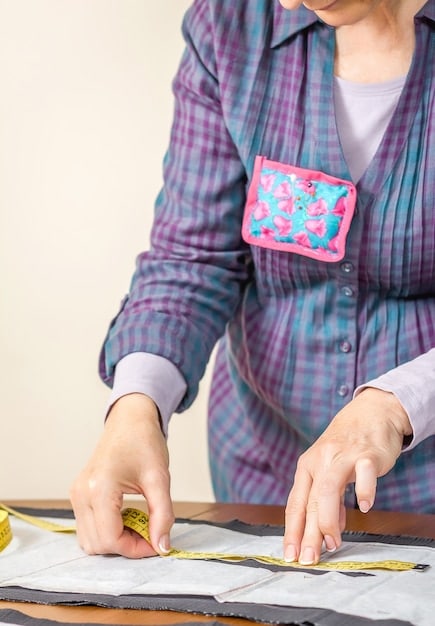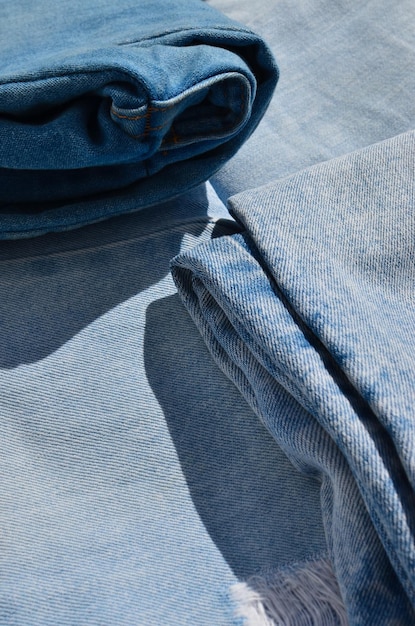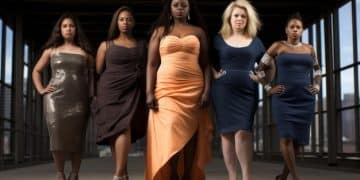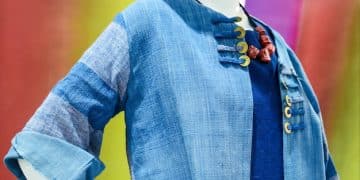Designer Spotlight: An American Leader in Ethical Fashion 2025

Designer Spotlight: The American Designer Championing Ethical Fashion Practices in 2025 celebrates a visionary American designer dedicated to revolutionizing the fashion industry through sustainable materials, fair labor practices, and innovative designs, setting a new standard for ethical fashion in the years to come.
In an era defined by increasing awareness of environmental and social responsibility, the fashion industry is undergoing a significant transformation. This **Designer Spotlight: The American Designer Championing Ethical Fashion Practices in 2025** aims to highlight an exemplary figure who is leading this change, demonstrating that style and ethical considerations can perfectly coexist.
The Rise of Ethical Fashion in America
The fashion industry has long been associated with environmental degradation and questionable labor practices. However, a shift is underway as consumers and designers demand greater transparency and accountability. The rise of ethical fashion in America reflects a growing awareness of these issues and a desire for more sustainable and socially responsible choices.
Ethical fashion encompasses a range of practices, including the use of sustainable materials, fair labor standards, and reducing waste throughout the supply chain. This movement is driven by designers who are committed to creating clothing that is not only stylish but also environmentally friendly and socially responsible.
Key Principles of Ethical Fashion
Ethical fashion is built on several core principles that guide designers and brands in their efforts to create a more sustainable industry.
- Sustainable Materials: Using materials that have a lower environmental impact, such as organic cotton, recycled fabrics, and innovative alternatives like pineapple leather (Piñatex) and mushroom leather (Mylo).
- Fair Labor Practices: Ensuring that garment workers are paid fair wages, work in safe conditions, and have access to benefits and protections.
- Transparency: Providing consumers with clear information about the origins of materials, the manufacturing process, and the social and environmental impact of their clothing.
- Waste Reduction: Minimizing waste through practices like zero-waste design, upcycling, and recycling programs.
By adhering to these principles, designers can create clothing that is not only fashionable but also contributes to a more sustainable and equitable world. This shift is crucial for the long-term health of the planet and the well-being of garment workers.
This section has explored the growing importance of ethical fashion in America, highlighting the key principles that drive this movement and the need for greater transparency and accountability within the industry. The next section will introduce an American designer who is championing these ethical practices and setting a new standard for fashion in 2025.
Introducing the Ethical Fashion Champion
This section introduces an American designer who embodies these principles and is championing ethical fashion practices. This designer is not just creating clothing; they are creating a movement towards a more sustainable and responsible fashion industry.
This designer’s journey into ethical fashion began with a deep understanding of the social and environmental implications of the industry. Witnessing firsthand the exploitation of garment workers and the detrimental effects of fast fashion on the environment, they made a conscious decision to create a brand that prioritizes people and the planet.

The Designer’s Background and Inspiration
The designer’s passion for ethical fashion is rooted in their personal values and experiences. Growing up in a community affected by the negative impacts of industrial pollution, they developed a strong sense of environmental responsibility.
- Early Influences: Exposure to environmental issues from a young age instilled a deep appreciation for nature and a commitment to conservation.
- Educational Background: Formal training in fashion design provided a solid foundation in garment construction and design principles, but also highlighted the industry’s shortcomings in terms of sustainability.
- Travel Experiences: Witnessing the working conditions of garment workers in developing countries motivated them to create a brand that prioritizes fair labor practices.
Fueled by these experiences, the designer set out to create a brand that would challenge the status quo and demonstrate that fashion could be both stylish and ethical. The designer’s background and inspiration serve as a strong foundation for their commitment to sustainable and responsible practices.
In summary, this section introduces a designer driven by a profound understanding of the fashion industry’s challenges and a personal commitment to ethical practices. The next section will explore the specific initiatives and strategies that this designer employs to promote ethical fashion within their brand.
Innovative Sustainable Materials
One of the key pillars of ethical fashion is the use of innovative sustainable materials. Conventional materials like cotton and polyester have significant environmental impacts, from pesticide use to greenhouse gas emissions.
The designer is committed to sourcing materials that have a lower environmental footprint. This includes using organic cotton, recycled fabrics, and exploring innovative alternatives that reduce waste and pollution. The use of these materials not only minimizes environmental harm but also supports local communities and promotes transparency within the supply chain.
Examples of Sustainable Materials
The designer’s commitment to sustainability is evident in the range of materials they use to create their collections.
- Organic Cotton: Grown without the use of synthetic pesticides or fertilizers, organic cotton reduces the risk of soil and water contamination.
- Recycled Fabrics: Using recycled polyester, nylon, and other materials reduces the demand for virgin resources and diverts waste from landfills.
- Innovative Alternatives: Exploring materials like Piñatex (pineapple leather), Mylo (mushroom leather), and Tencel (lyocell) offers new possibilities for sustainable fashion.

The designer actively seeks out suppliers who share their commitment to sustainability. This includes working with farmers who use organic farming practices, textile mills that prioritize water conservation, and manufacturers that adhere to fair labor standards. By using innovative sustainable materials, the designer sets a new standard for environmental responsibility within the fashion industry.
In conclusion, this section has examined the importance of innovative sustainable materials in ethical fashion, highlighting the designer’s commitment to sourcing materials with a lower environmental footprint. The next section will delve into the ethical labor practices that the designer employs to ensure fair treatment of garment workers.
Ethical Labor Practices and Fair Wages
Beyond sustainable materials, ethical labor practices are a cornerstone of the designer’s approach. The fashion industry has a history of exploitation, with garment workers often facing low wages, unsafe working conditions, and long hours.
This designer is committed to ensuring that all workers involved in the production of their garments are treated with respect and dignity. This includes paying fair wages, providing safe working conditions, and empowering workers to have a voice in their workplace. By prioritizing ethical labor practices, the designer demonstrates a commitment to social responsibility and promotes a more equitable fashion industry.
The Importance of Fair Wages
Paying fair wages is essential for ensuring that garment workers can meet their basic needs and live with dignity.
- Living Wage: The designer is committed to paying a living wage that covers the cost of food, housing, healthcare, and education for workers and their families.
- Transparency: The designer provides transparent information about wages and working conditions to consumers, allowing them to make informed purchasing decisions.
- Worker Empowerment: The designer supports worker empowerment initiatives, such as training programs and worker-led organizations, that give workers a voice in their workplace.
The designer partners with factories and suppliers that share their commitment to ethical labor practices. This includes conducting regular audits to ensure that factories comply with labor laws and international standards. By prioritizing ethical labor practices and fair wages, the designer sets a new standard for social responsibility within the fashion industry.
This section has highlighted the importance of ethical labor practices and fair wages in ethical fashion, showcasing the designer’s commitment to ensuring the well-being of garment workers. The next section will explore the designer’s innovative designs and collections that seamlessly blend style with sustainability.
Blending Style with Sustainability
The designer has demonstrated that ethical fashion can be both stylish and sustainable, creating collections that appeal to fashion-conscious consumers while adhering to the highest ethical standards.
The designer’s collections reflect a deep understanding of current fashion trends and a commitment to timeless design principles. The clothing is designed to be versatile, durable, and made to last, reducing the need for frequent replacements and minimizing waste. By blending style with sustainability, the designer is proving that ethical fashion can be both desirable and responsible.
Key Design Elements
The designer’s collections are characterized by several key design elements that reflect their commitment to sustainability and style.
- Timeless Designs: Creating classic silhouettes that transcend fleeting trends, ensuring that the clothing remains relevant and wearable for years to come.
- Versatile Pieces: Designing clothing that can be mixed and matched to create multiple outfits, reducing the need for a large wardrobe.
- Durability: Using high-quality materials and construction techniques to ensure that the clothing is durable and long-lasting.
The designer is also committed to transparency in their design process, providing consumers with information about the materials used, the manufacturing process, and the ethical implications of their clothing. By blending style with sustainability, the designer is challenging the notion that ethical fashion must be boring or unfashionable.
In summary, this section highlights the designer’s success in blending style with sustainability, creating collections that are both fashionable and ethical. The next section will delve into the designer’s efforts to promote transparency and traceability within the fashion industry.
Promoting Transparency and Traceability
Transparency and traceability are essential for building trust with consumers and promoting accountability within the fashion industry. Consumers want to know where their clothing comes from, who made it, and what impact it has on the environment and society.
The designer is committed to providing consumers with clear and transparent information about their supply chain. This includes tracing the origins of materials, disclosing the names and locations of factories, and providing detailed information about wages and working conditions. By promoting transparency and traceability, the designer empowers consumers to make informed purchasing decisions and holds the fashion industry accountable for its practices.
Transparency Initiatives
The designer has implemented several initiatives to promote transparency and traceability within their brand.
- Supply Chain Mapping: Tracing the origins of materials from the farm or factory to the finished garment, providing consumers with a clear picture of the supply chain.
- Factory Disclosure: Publishing the names and locations of factories on the brand’s website, allowing consumers to see where their clothing is made.
- Impact Reporting: Providing detailed information about the environmental and social impact of the brand’s products, including water usage, carbon emissions, and worker wages.
The designer also uses technology to enhance transparency, such as QR codes on garments that provide consumers with access to detailed information about the product’s history and impact. By promoting transparency and traceability, the designer is setting a new standard for accountability within the fashion industry.
This section has examined the importance of transparency and traceability in ethical fashion, highlighting the designer’s commitment to providing consumers with clear and transparent information about their supply chain. The final section will summarize the designer’s contributions to ethical fashion and consider the future of sustainable practices in the industry.
| Key Aspect | Brief Description |
|---|---|
| 🌱 Sustainable Materials | Focus on organic, recycled, and innovative fabrics like Piñatex. |
| 🤝 Ethical Labor | Ensuring fair wages and safe working conditions for all garment workers. |
| 🔍 Transparency | Providing clear information about the supply chain and manufacturing process. |
| 👚 Stylish Designs | Blending modern aesthetics with eco-conscious practices. |
FAQ
▼
Ethical fashion incorporates sustainable materials, fair labor practices, and transparency. It ensures minimal environmental impact and fair treatment of workers throughout the supply chain.
▼
Transparency builds consumer trust and holds brands accountable. Knowing where materials come from and how products are made allows for informed purchasing decisions.
▼
Examples include organic cotton, recycled polyester, Piñatex (pineapple leather), and Mylo (mushroom leather). These alternatives reduce environmental degradation compared to traditional materials.
▼
Fair labor ensures garment workers receive fair wages, work in safe conditions, and have access to benefits. This contrasts with the historical exploitation prevalent in the fashion industry.
▼
Consumers can support ethical fashion by purchasing from transparent brands, seeking out sustainable materials, and advocating for fair labor practices. Informed choices drive industry change.
Conclusion
In conclusion, the American designer highlighted in this spotlight exemplifies the future of ethical fashion. By prioritizing sustainable materials, ethical labor practices, transparency, and stylish designs, they are setting a new standard for the industry and inspiring consumers to make more responsible choices.





